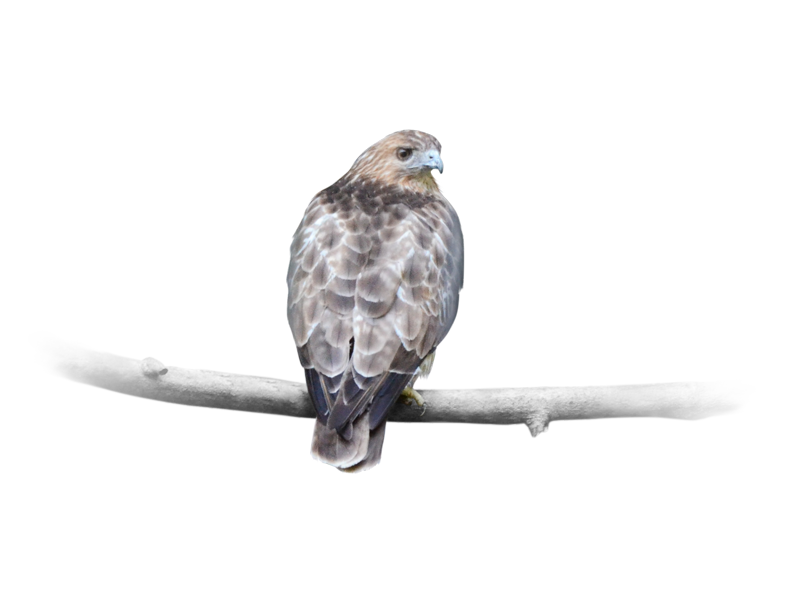
Buteo japonicus (Temminck & Schlegel, 1844)
ノスリはなぜ「狂った鳥」なのか?
Why is the Buzzard Called “The Mad Bird” ?
ノスリは全長50〜60センチ、翼を広げると最大140センチほどになる中型のタカの仲間です。日本では北海道から九州まで広く分布し、北海道・本州・四国では留鳥、九州以南では冬鳥として見られます。農耕地や草原、河原などの開けた場所を好み、「ピイヨー」と鳴く声が特徴的です。
大空を円を描くように舞い、時には羽ばたきを止めて空中に静止する「ホバリング」を行います。地上の動きを見つけると急降下して獲物を捕らえ、主にネズミやカエル、小鳥などを食べます。トビによく似ていますが、ノスリは白い翼に茶色の斑点、扇形の尾羽が特徴です。
さて、ノスリの漢字「鵟(くわう)」は「狂った鳥」と書きます。しかし、実際のノスリはおだやかで落ち着いた鳥です。では、なぜ「狂」という字が使われているのでしょうか。
古代中国では「鵟」という字はタカやワシに似た猛禽を指すと同時に、「夢に現れる鳥」や「不思議な鳥」といった神秘的な存在を意味しました。夜に活動するフクロウのような鳥が「常ならぬ」「狂気をはらむ」とされたことから、この字に「狂」の意味が加わったと考えられます。つまり「狂った鳥」とは、気性の荒い鳥ではなく、異界を行き来するような特別な鳥を指す言葉だったのです。
一方、日本語の「ノスリ」は、地上近くを「野を擦る」ように飛ぶ姿から生まれたとされます。また、韓国語でタカ類を「スリ」と呼ぶことから、「野にいるスリ」=「ノスリ」となったという説もあります。
こうして見ると、「鵟」という漢字と「ノスリ」という名には、古代の人々が抱いた鳥への畏敬や神秘の感覚が今も息づいているのです。
The Common Buzzard (Buteo buteo japonicus) is a medium-sized bird of prey, about 50–60 cm in length with a wingspan reaching up to 140 cm.
In Japan, it is widely distributed from Hokkaido to Kyushu—resident in Hokkaido, Honshu, and Shikoku, and a winter visitor further south. It favors open habitats such as farmland, grasslands, and riverbeds, and is known for its distinctive call, a high “pii-yoh” cry that echoes through the fields.
Buzzards soar gracefully in wide circles and sometimes hover motionless in the air—a behavior known as “hovering.” When they spot movement on the ground, they dive swiftly to catch prey such as mice, frogs, snakes, or small birds. Although often mistaken for the Black Kite (Milvus migrans), the buzzard can be distinguished by its white wings with brown spots and its fan-shaped tail.
The kanji for buzzard, 鵟, literally means “mad bird.” Yet the buzzard is calm and composed, far from “mad.” Why, then, was such a character used?
In ancient China, the character 鵟 referred not only to hawks and eagles but also to mythical or mysterious birds that appeared in dreams. Nocturnal species like owls, whose behavior seemed strange and otherworldly, were sometimes described as “crazy” or “possessed.” Over time, this idea became associated with the character’s meaning of “madness.”Thus, “the mad bird” does not refer to a bird’s temperament but to one thought to move between the natural and the supernatural worlds.
The Japanese name Nosuri has a different origin. It likely comes from an older word meaning “to brush the fields,” referring to the bird’s low, gliding flight. Another theory links it to the Korean word suri, meaning “hawk,” suggesting that nosuri originally meant “the hawk of the fields.”
Together, the kanji 鵟 and the name Nosuri preserve the ancient reverence people once felt for birds—creatures that seemed to bridge the sky and the unseen world.
参考文献
国土交通省北海道開発局 | 治水課 | 十勝の川の生き物たち 十勝の川生物図鑑 | ノスリ 2025年10月18日閲覧
野鳥情報.com | トビとノスリの違いと見分け方 | (2020年8月30日) 2025年10月18日閲覧
土佐料理 旬の鰹がゆく! | 田園のノスリ | (2014年12月20日) 2025年10月18日閲覧
C.E.C. | コラム | 徒然野鳥記 | 第93回 ノスリ | (2009年8月1日) 2025年10月18日閲覧
漢典 HanDian | 鵟 2025年10月18日閲覧